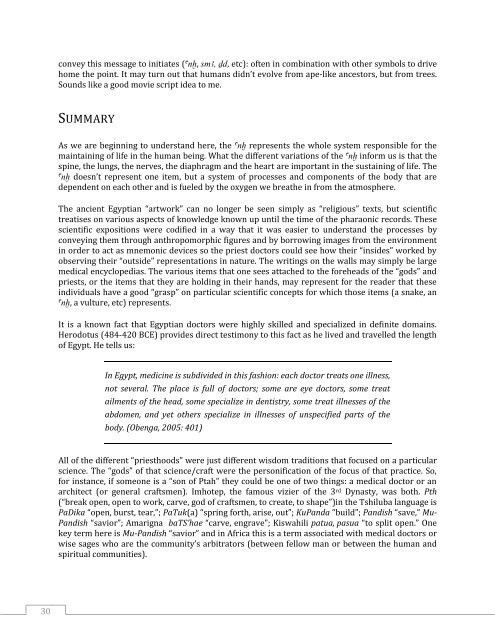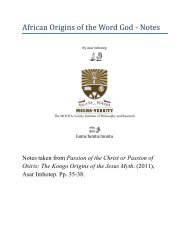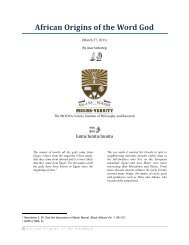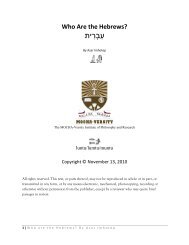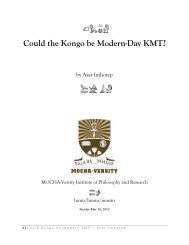reinterpretations of the ankh symbol part 2 - Asar Imhotep
reinterpretations of the ankh symbol part 2 - Asar Imhotep
reinterpretations of the ankh symbol part 2 - Asar Imhotep
You also want an ePaper? Increase the reach of your titles
YUMPU automatically turns print PDFs into web optimized ePapers that Google loves.
30<br />
convey this message to initiates (anx, smA, Dd, etc): <strong>of</strong>ten in combination with o<strong>the</strong>r <strong>symbol</strong>s to drive<br />
home <strong>the</strong> point. It may turn out that humans didn’t evolve from ape-like ancestors, but from trees.<br />
Sounds like a good movie script idea to me.<br />
SUMMARY<br />
As we are beginning to understand here, <strong>the</strong> anx represents <strong>the</strong> whole system responsible for <strong>the</strong><br />
maintaining <strong>of</strong> life in <strong>the</strong> human being. What <strong>the</strong> different variations <strong>of</strong> <strong>the</strong> anx inform us is that <strong>the</strong><br />
spine, <strong>the</strong> lungs, <strong>the</strong> nerves, <strong>the</strong> diaphragm and <strong>the</strong> heart are important in <strong>the</strong> sustaining <strong>of</strong> life. The<br />
anx doesn’t represent one item, but a system <strong>of</strong> processes and components <strong>of</strong> <strong>the</strong> body that are<br />
dependent on each o<strong>the</strong>r and is fueled by <strong>the</strong> oxygen we brea<strong>the</strong> in from <strong>the</strong> atmosphere.<br />
The ancient Egyptian “artwork” can no longer be seen simply as “religious” texts, but scientific<br />
treatises on various aspects <strong>of</strong> knowledge known up until <strong>the</strong> time <strong>of</strong> <strong>the</strong> pharaonic records. These<br />
scientific expositions were codified in a way that it was easier to understand <strong>the</strong> processes by<br />
conveying <strong>the</strong>m through anthropomorphic figures and by borrowing images from <strong>the</strong> environment<br />
in order to act as mnemonic devices so <strong>the</strong> priest doctors could see how <strong>the</strong>ir “insides” worked by<br />
observing <strong>the</strong>ir “outside” representations in nature. The writings on <strong>the</strong> walls may simply be large<br />
medical encyclopedias. The various items that one sees attached to <strong>the</strong> foreheads <strong>of</strong> <strong>the</strong> “gods” and<br />
priests, or <strong>the</strong> items that <strong>the</strong>y are holding in <strong>the</strong>ir hands, may represent for <strong>the</strong> reader that <strong>the</strong>se<br />
individuals have a good “grasp” on <strong>part</strong>icular scientific concepts for which those items (a snake, an<br />
anx, a vulture, etc) represents.<br />
It is a known fact that Egyptian doctors were highly skilled and specialized in definite domains.<br />
Herodotus (484-420 BCE) provides direct testimony to this fact as he lived and travelled <strong>the</strong> length<br />
<strong>of</strong> Egypt. He tells us:<br />
In Egypt, medicine is subdivided in this fashion: each doctor treats one illness,<br />
not several. The place is full <strong>of</strong> doctors; some are eye doctors, some treat<br />
ailments <strong>of</strong> <strong>the</strong> head, some specialize in dentistry, some treat illnesses <strong>of</strong> <strong>the</strong><br />
abdomen, and yet o<strong>the</strong>rs specialize in illnesses <strong>of</strong> unspecified <strong>part</strong>s <strong>of</strong> <strong>the</strong><br />
body. (Obenga, 2005: 401)<br />
All <strong>of</strong> <strong>the</strong> different “priesthoods” were just different wisdom traditions that focused on a <strong>part</strong>icular<br />
science. The “gods” <strong>of</strong> that science/craft were <strong>the</strong> personification <strong>of</strong> <strong>the</strong> focus <strong>of</strong> that practice. So,<br />
for instance, if someone is a “son <strong>of</strong> Ptah” <strong>the</strong>y could be one <strong>of</strong> two things: a medical doctor or an<br />
architect (or general craftsmen). <strong>Imhotep</strong>, <strong>the</strong> famous vizier <strong>of</strong> <strong>the</strong> 3 rd Dynasty, was both. Pth<br />
(“break open, open to work, carve, god <strong>of</strong> craftsmen, to create, to shape”)in <strong>the</strong> Tshiluba language is<br />
PaDika “open, burst, tear,”; PaTuk(a) “spring forth, arise, out”; KuPanda “build”; Pandish “save,” Mu-<br />
Pandish “savior”; Amarigna baTS’hae “carve, engrave”; Kiswahili patua, pasua “to split open.” One<br />
key term here is Mu-Pandish “savior” and in Africa this is a term associated with medical doctors or<br />
wise sages who are <strong>the</strong> community’s arbitrators (between fellow man or between <strong>the</strong> human and<br />
spiritual communities).


